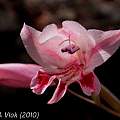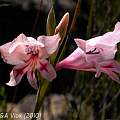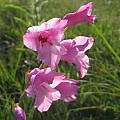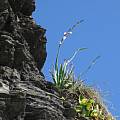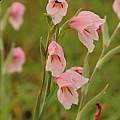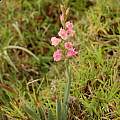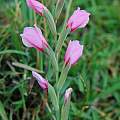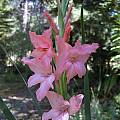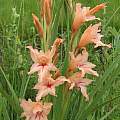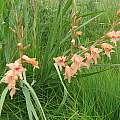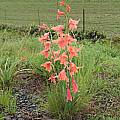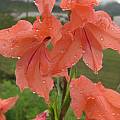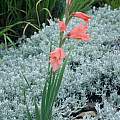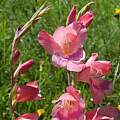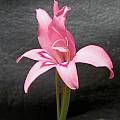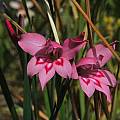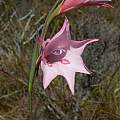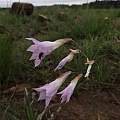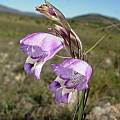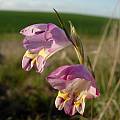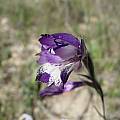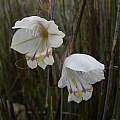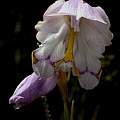From pale rose and mauve to salmon to screaming pink, this color complex offers many shades and the widest range of species in the color indices.
Page 1: G. anatolicus... Page 2: G. carmineus... Page 3: G. densiflorus... Page 4: G. gracilis... Page 5: G. maculatus... Page 7: G. phoenix... Page 8: G. saxatilis... Page 9: G. vernus...
Gladiolus nigromontanus Goldblatt is a rare South African species that occurs only on rocky outcrops on sandstone slopes in the Swartberg Mountains. Flowering in autumn (March) and best a few years after a fire, it grows to 30 cm with narrow leaves and small white long tubed flowers suffused light pink and marked with red and yellow on the three lower lobes. Flowers are in a 3 to 6 flower spike. Photos from the book Plants of the Klein Karoo courtesy of Jan and Anne Lise Schutte-Vlok.
Gladiolus ochroleucus grows in grasslands and light bush or woodland in the Eastern Cape. Flowers are either shades of pink, sometimes light purple or reddish, or whitish or yellow flushed brownish on the reverse. The lower tepals are white in the lower half sometimes with dark red-purple median streaks. The first two photos by Cameron McMaster were taken January 2008 in the Eastern Cape. Photos number three, four, and five were taken near Morgan Bay by Bob Rutemoeller and Mary Sue Ittner.
Gladiolus oppositiflorus Herb. is found in the southern part of the summer rainfall area where it grows in open grasslands and often in rocky sites where there is some protection from predators. Flowers are salmon to pale pink or mauve, with the lower three tepals paler in the midline and having a reddish to purple median streak. This species blooms summer into fall. The first two photos by Mary Sue Ittner of a plant growing in the ground in Northern California and blooming late August-September 2004. The last two photos were taken by Cameron McMaster at Maclear in the Eastern Cape February 2008.
A shorter-stemmed form with salmon colored flowers was described as Gladiolus salmoneus Baker and later considered to be Gladiolus oppositiflorus ssp. salmoneus (Baker) Oberm. Although this subspecies is still recognized by Kew, Goldblatt and Manning in Gladiolus of Southern Africa did not think the differences warranted subspecies treatment. The first two photos of this form taken in the Eastern Cape January 2008 by Cameron McMaster. The last photo is from Rachel Saunders.
Gladiolus ornatus Klatt is found on marshy sandstone and granite slopes in the Southwestern Cape, South Africa. Growing from 25 to 35 cm high, it has linear leaves and pink unscented flowers in a funnel shaped tube in a one to three flowered spike. The lower tepals each have a spear to spade shaped white median streak edged in dark pink and the lower part of the throat is white streaked with dark pink. Flowering is from September to November. Photo by Rachel Saunders.
Gladiolus paludosus grows in Mpumalanga in marsh and vlei habitats that are wet much of the year. It has short-tubed pink or mauve, occasionally red unscented flowers; the lower lateral tepals have a broad diamond-shaped to semicircular band of dark mauve or purple across the midline. Flowering time is mid October to mid November. It is very similar to Gladiolus crassifolius, but grows in a different habitat, flowers earlier, and has softer textured leaves and bracts. Photo taken by Rachel Saunders January 2015, much later than the usual flowering time.
Gladiolus pappei grows in marshes on sandstone slopes in the southwestern Cape. It flowers in spring. The first two photos show a plant that was grown from Silverhill seeds sown in September 2001 and first blooming in June 2003. Photos by Bob Rutemoeller and Mary Sue Ittner. The last photo was taken by Rachel Saunders.
Gladiolus parvulus Schltr. is restricted to the southern half of KwaZulu-Natal, South Africa, into Lesotho where it grows in thin soil on sandstone pavements or in cracks in sandstone outcrops at elevations up to 3300 m. Growing from 15 to 35 cm, it has two leaves, the larger sheathing the stem and the second a small bract-like leaf immediately below the lowest flower. It has small horizontal to almost nodding light pink flowers with equal tepals. The flowers have been described as looking more like an Ixia or a Dierama. It flowers October to early December. Photo from Rachel Saunders.
Gladiolus patersoniae is widespread in the southern African winter rainfall areas. It occurs in exposed rocky habitats in the interior ranges of the Cape Floral region, but also near the coast at Cape Infanta and on stony alluvial flats near Worcester. It grows on soils derived from sandstone. Plants grow to 50 cm and have narrow cylindrical leaves. The bell like short tubed and sweetly scented (similar to apple and carnation) pale to deep blue, slate, grey or cream flowers are pollinated by long tongued bees. The lower three tepals have a transverse yellow band usually outlined in dark blue or purple. Flowering occurs in late winter to spring, earlier at lower elevations. The first five photos by Cameron McMaster. His last one was taken August 2012 at the top of Potjiesberg Pass south of Uniondale (Eastern Cape) where it was growing with Gladiolus mutabilis. The last photo from the book Plants of the Klein Karoo courtesy of Jan and Anne Lise Schutte-Vlok.
Page 1: G. anatolicus... Page 2: G. carmineus... Page 3: G. densiflorus... Page 4: G. gracilis... Page 5: G. maculatus... Page 7: G. phoenix... Page 8: G. saxatilis... Page 9: G. vernus...
